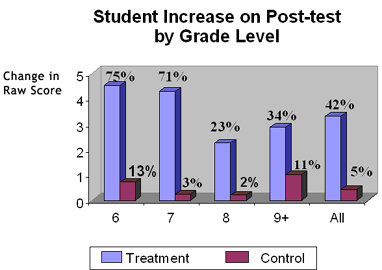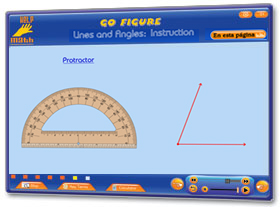
Program Information
HELP Program Instructional Pedagogy
- HELP Instructional Pedagogy
HELP employs a research-based pedagogy for teaching ELLs mathematics and other academic content that had proved effective in a classroom setting. This instructional methodology is called Sheltered Instruction Observation Protocol or the SIOP Model (Short & Echevarria, 1999). The sheltered method—devised initially for ELLs—is proving to be increasingly popular with non-ELL teachers and has demonstrated remarkable success with non-ELL students in a classroom setting.
-
HELP Math is the first instructional program to successfully incorporate sheltered instruction practices into a comprehensive academic curriculum using technology.
HELP’s sheltered instruction is designed to improve a student’s understanding of the content, while simultaneously developing their English language proficiency using specific techniques:
- Increasing comprehensibility by scaffolding the learning, e.g. breaking down concepts into small, comprehensible “learning chunks”; synchronizing visuals, audio and interactivity.
- Targeting vocabulary development by emphasizing math content language as well as academic English; available to students as hyperlinked words within the instruction, and within an online dictionary of mathematical terms.
- Providing bilingual support which offers further student support. Teacher has the option of switching on/off.
- Explicitly teaching problem-solving and test-taking skills, providing multiple opportunities for student responses and immediate corrective feedback when errors are made.
- If you would like more information about the National Clearinghouse for English Language Acquisition and Language Instruction Educational Programs NCELA; please click this link.
Research-based
HELP has been extensively field-tested and evaluated since the project’s onset five years ago. In an initial pilot, HELP
Numbers Make Sense lessons were tested by an independent researcher (Dr. Tran) with funding from the Colorado Department of Education. The tests used a randomized pre-post, two-group (treatment, control) design. The results of the evaluation (white paper available) clearly demonstrate that HELP is an effective tool in increasing ELLs’ math ability.
 |
Showed gains of more than 70% for 6th & 7th graders on standards-aligned tests (National Council for Teachers of Mathematics) |
Research shows that students’ quick mastery of the program contributes to increased self-esteem and an increase in perceived ability to learn math. Teachers observed that HELP lessons captured their students’ attention (students stay on task for about 30 minutes per sitting). Teachers also liked that the program was easy to use and believed that it can increase their ability to provide individualized instruction to their students. The HELP program was awarded a large multi-year U.S. Department of Education grant to further research and develop the program. University of Colorado research uses an experimental model involving approximately 1,000 students across 5 states: Texas, California, New York, Oregon and Colorado. Student achievement on the end-of-modules quizzes has been high (in some cases in excess of 300%) and teacher feedback on the program and training (from surveys and focus groups) has been extremely positive confirming the findings of the initial research.
Research teachers and administrators cite these primary benefits:
- Students are frequently “glued to the computer & don’t want to leave at the end of class”
- Computer-based sheltered instruction promotes consistent delivery of math content
- The teacher does not need to be a qualified math teacher or SIOP trained
- A non-threatening environment where ELLs feel “safe emotionally to practice & learn”
Click here for complete HELP Evaluation White Paper
Key Features
HELP Math is the first digital, supplemental curriculum in the U.S. to address the specific issues of teaching mathematics to English Language Learners (ELLs). Students can simultaneously see, hear and manipulate the math content. The program shelters learning and provides interactive support and feedback loops which encourage math content knowledge and math skill development, as well as math terms and general academic English acquisition.
|
HELP Math engages students through interactive multimedia lessons that break down math terms and math concepts, so that students can easily understand and retain the math content |
 |
HELP Math Middle School (Grades 6-8) has 44 comprehensive lessons (over 100 hours of instruction), with four, 12 lesson series (two-three self-paced hours each):
Numbers Make Sense – correlates to Numbers & Operations (Grades 6-8)
Geometry ~ Go Figure! – correlates to Geometry (Grades 6-8)
Algebra ~ From ABC to XYZ – correlates to Algebra (Grades 6-8)
Data Analysis ~ How Likely! – correlates to Data Analysis & Statistics (Grades 6-8)
HELP Elementary School (Grades 3-5) has 29 comprehensive lessons (over 100 hours of instruction), with two-three self-paced hours each:
Numbers and Operations – (Grade 3-5)
Numbers and Operations Algebra – (Grade 3-5)
Geometry and Measurement – (Grade 3-5)
Key Features:
- Student-centered, enabling students to engage with material at their own pace. On the computer, students can move faster or slower through a lesson depending on their ability.
- Highly interactive, colorful and musical. Trigger multiple modalities, incorporating voice, music, visuals, text, and interactivity.
- Research-based as part of a large, multi-year U.S. Department of Education grant; research is conducted by the University of Colorado, using an experimental model with >1,000 students across 6 states.
- Proven Effective showing gains of more than 70% for 6th and 7th grade ELL students on standards-aligned tests (NCTM) in independent research funded by the Colorado Department of Education.
- Delivers “Sheltered Instruction” techniques using technology, a proven, research based educational approach for teaching academic content to ELLs such as visuals, repetition, and recycling prior knowledge to make content instruction comprehensible to the student while developing English language skills (Short and Echevarria, 1999).
- Aligns directly to math standards: National Council of Teachers of Mathematics (NCTM) and to high-ELL state content standards and assessment frameworks for mathematics (grades 6-8).
- Targets vocabulary development: Spanish/English hyperlinked key terms and glossary with pictorial examples and audio reinforcement.
- Teaches test-taking skills: how to read, comprehend and answer ‘look alike’ questions from state standardized math tests.
- Provides interactive feedback and constructive suggestions for improvement.
Teacher Support Tools
- Teachers’ Resource Guides including: interactive alignment tables to NCTM and state math standards, English language acquisition best practice ELL methodology, case studies for implementing the HELP program in a variety of settings
- Teachers can design a custom curriculum for each student in their class and thus create a unique learning path to meet individual student requirements, e.g. assign particular lessons, turn on/off the Spanish audio support, calculator, etc.
- Online HELP tutorials (English and Spanish) and a free telephone and Web Ex orientation training session to explain product navigation and functionality
- Dynamic quizzes and randomization of test questions
- Auto scoring of student quizzes. Students receive a printable report which highlights specific areas that require further remediation, pinpointing the particular standards that need to be reviewed
- Real-time tracking and monitoring of student progress, e.g. student time spent on task
- Auto generation of teacher reports; exportable to Excel e.g. lessons completed, quiz scores, etc.
- Easy password administration and monitoring/tracking student time on task
Professional Development
HELP professional development components include:
- Face-to-face workshops
- Monthly Webinars
- Accredited courses by University of Colorado (3 credits, 45 hours available)
- Print materials including: resource guides, standards alignment tables, and online tutorials
Alignment to Standards
There are 44 lessons in the HELP Math Middle School (Grades 6-8) program. The lessons align to the National Council of Teachers of Mathematics “NCTM” standards Grades 6-8, as well as to high-ELL state math content standards. Unlike most programs, which align to state standards only at a superficial level, the HELP Program is aligned at the finest level of detail; the state content standard benchmarks, e.g. the particular elements that the "student needs to know, understand and be able to do".
HELP also aligns to English Language Acquisition “ELA” best practice principles including TESOL (National Association of Teachers of English to Speakers of Other Languages) Standards, the Colorado Department of Education ELL Guidebook, and a composite of a variety of school districts’ English Language Development continuums.
Interactive standards-alignment tables are provides, allowing the teacher to move from standards to lessons and lessons to standards.
CLICK HERE for a sample alignment table.
Technical Information
- The HELP Program is internet-based and can be used on Windows or Mac.
- The program is web hosted by Digital Directions. If a school's Internet connection is too slow, a highly efficient specialized content-caching server can be used in the school at a very reasonable cost.. We can assist in determining the scope of the implementation and the optimal configuration of licenses for your schools.
Client Hardware Requirements:
- A broadband Internet connection.
- A Pentium PC processor with a minimum of 200 MHz clock speed, or an Apple Power Macintosh or later version computer.
- At least 64 Mb RAM.
- Minimum 800 x 600 screen resolution.
Client Software Requirements:
- Windows 2000 (or later) or Mac OS Version 7.5 (or later).
- Browser: Most popular Web browsers are compatile.
- The latest Macromedia Flash Plug-in.
|




